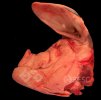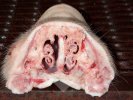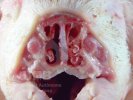Atrophic Rhinitis
Rhinitis is inflammation of the tissues inside the nose where the nose may become distorted (atrophy).
Alternative names: Progressive Atrophic Rhinitis, PAR
Information
Rhinitis as a general term means nostril’s tissue swelling, and can be caused by a wide variety of bacteria, virus and irritating substances. This condition rarely originates a clinical disease in adult pigs. Atrophy means upper respiratory tract tissue is damaged, shrink and deformed. The disease has two presentations:
- Mild and non-progressive, in which the infection or irritation occurs during a period of 2 to 3 weeks. After that, the swelling stops and nasal turbinates cure, being normal again.
- The most severe form of progressive atrophic rhinitis (PAR) in which strains of Pasteurella multocida type D and Bordetella bronchiseptica produce toxins that damage the nasal tissue. When both pathogens are present in the farm, they cause a continuous inflammation in lactating piglets and growing pigs, causing atrophy of tissues and deformities in the nose.
Symptoms
Sows
- Not clinical signs.
- Distortion of the nose.
Lactating piglets
- Sneezes.
- Tearing.
- Nasal discharges that sometimes present blood.
- Distortion of the nose.
Weaners and growers
- Blood stained sneezes.
- Tearing.
- The nose twists, shrinks and wrinkles.
- Weight gain and daily growth decrease.
- Feed conversion ratio increases.
- Increase of respiratory diseases.
Causes / Contributing Factors
- The disease is transmitted from one farm to another through carrier pigs, clothes, equipment, etc.
- The transmission inside the farm is through aerosols between pigs, or through mouth-to-mouth contact.
- Is more frequent in farms with a young breeding herd, especially those ones having high gilt numbers.
- Multi-lactation systems (piglets suck from more than one sow) increase the disease spread.
- Inadequate ventilation.
- Environments with high amounts of dust or ammonia.
- Toxic gases.
- Deficient environment and nutrition increase the severity.
Diagnosis
- Clinical signs especially deviated snouts.
- Nasal swab culture.
- Evaluation of nasal turbinates and septum through slaughter checks and on-farm necropsies.
Control/Prevention
- All adult animals must be vaccinated twice with a difference of 4 to 6 weeks between vaccinations. Modern vaccines are very efficient.
- Then, sows must be vaccinated 4 to 6 weeks before farrowing.
- Sometimes piglets must also be vaccinated at 1 and 4 weeks of age.
- Early weaning of piglets <12 days of age to an off-site nursery.
- During specific elimination programs, strategic use of antibiotics can be used.
Atlas of pathology
See images in the Altlas related to Atrophic Rhinitis





